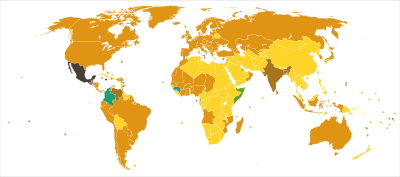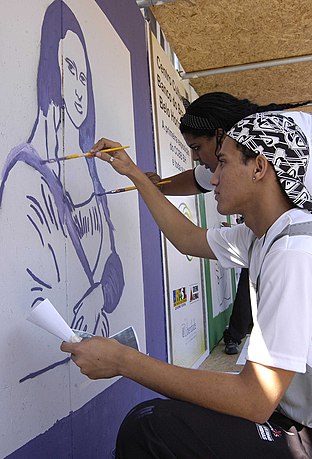Commons:Copyright rules
Files uploaded to Commons should be free both in the country of origin (as defined by the Berne Convention) and in the United States of America, and possibly in other countries involved, either through being properly licensed by the copyright owner or being in the public domain.
Copyright rules by subject matter
- Main page: Commons:Copyright rules by subject matter.
Commons:Copyright rules by subject matter brings together a variety of subjects and aims to answer the question "Can I upload photographs/pictures of ...?"
It is ![]() OK to upload:
OK to upload:
- Generally, photos you have taken yourself of uncopyrightable subjects such as views; nature; yourself; and people who have given their consent for you to photograph them and for you to publish the photograph. (However, you should remember that uploads should be educational - Commons is not your private web space.)
- Photos taken by you, or scans or photocopies made by you of objects or designs whose copyright has expired (usually 70 years after the death of the author, but see Commons:Copyright rules by territory for a country-by-country list).
- Mere mechanical scans or photocopies, made by somebody else, of an object or design old enough to be in the public domain (usually 70 years after the death of the author, but see Commons:Copyright rules by territory for a country-by-country list). For scans of old images that may have been enhanced, see Commons:When to use the PD-scan tag.
- Photographs, taken either by yourself or someone else, that are faithful reproductions of 2D public domain works of art. See Commons:When to use the PD-Art tag.
Other subjects may or may not be allowable - see headings at Commons:Copyright rules by subject matter. If you want to have an answer to the question "Can I upload photographs/pictures from ...?", see the section at Commons:Copyright rules by subject matter on Internet images. See also: Commons:Threshold of originality.
Simple checklist
Let's assume you took a picture with your camera, or you've scanned it from somewhere, or you've downloaded it off a web server - and want to upload it to Wikimedia Commons. How do you know what's OK and what's not? Here's a simple chart that helps you decide. In cases of doubt, read the further advice for your country first. If you still don't know for sure, ask on Commons:Help desk or Commons:Village pump in your local language.
See Commons:Copyright rules by subject matter for a more complete list.
 OK
OK
Your own photos of:
- Nature (forest, sky, etc.)
- Animals (cats, dogs, etc.)
- Insects (ants, beetles, etc.)
- Produce (apples, tomatoes, etc.)
- People who have given their consent for their image to be published
- You (as long as you don't use this as your private webspace), but not pictures others took of you (these require the consent from whoever took the picture)
- Objects that are public domain by age both in the United States and your jurisdiction:
- Buildings built by an architect who died 70+ (preferably 100+) years ago
- Works of art created by an artist who died 70+ (preferably 100+) years ago and first published before 1929
- Books by authors who died 70+ (preferably 100+) years ago and first published before 1929
- Newspapers and Magazines published by an author who died 70+ (preferably 100+) years ago and first published before 1929
Own scans of:
- Material where copyright has expired in both your jurisdiction and the United States.
- Pictures created entirely by you (based either on no earlier source or on a source which is in the public domain)
Material from web servers:
- Material where copyright has expired in your jurisdiction, the United States and the jurisdiction of the web server.
Questionable, may or may not be OK
All kinds of copyrighted material, when uploader does not own the copyright:
- Logos. Only very simple designs are OK, see Commons:Licensing section on Simple design.
- Screenshots. See Commons:Screenshots.
Photographs, drawings, scans and other reproductions of:
- Cars (cars with only one color and without any ads, paintings etc. are OK)
- Products of daily use (utilitarian designs are OK)
- Book covers (only very simple designs are OK)
- Currency (depends on country law; please see Commons:Currency)
- Stamps (depends on country law; please see Commons:Stamps)
- Buildings built by an architect who died less than 70 years ago or is still alive. See Commons:Freedom of panorama.
- Permanently installed works of art in a public place, created by an artist who died less than 70 years ago or is still alive. See Commons:Freedom of panorama.
- Interiors of private houses, homes, museums.
- Celebrities. See Commons:Photographs of identifiable people.
- Normal people who have not given their consent. See Commons:Photographs of identifiable people.
 Not OK
Not OK
- Fair use images. See Commons:Fair use.
- Fan art that closely resembles copyrighted material. See Commons:Fan art.
- Reproductions of objects that are copyrighted by someone other than you, like the following:
- Action figures, statuettes and other copyrighted material. See Commons:Derivative works.
- Album, videogame, movie and other commercial products covers, posters, newspapers and magazines whose copyright has not expired (covers and interiors).
- Sounds of things that are copyrighted by someone other than you, like the following:
- Copyrighted radio stations (programs and commercials)
- Lyric songs created by an author whose copyright has not expired
Copyright rules by territory
- Main page: Commons:Copyright rules by territory.

Laws about copyright differ from country to country. Images uploaded to Commons, unless uploaded from the United States, involve the interaction of two or more copyright jurisdictions. The laws of individual countries differ especially in the following points:
- The time for which a copyright applies. In most countries, copyright expires no later than 70 years after the death of the author (p.m.a.). There may be special terms for recently published old material.
- Status of works of the government. In many (but not all) countries, documents published by the government for official use are in the public domain.
- Material applicable for copyright. In some jurisdictions, pictures of artistic work like architecture, sculptures, clothing etc. can not be used freely without the consent of the creator of the original artwork.
Almost all countries in the world are party to the Berne Convention for the Protection of Literary and Artistic Works (see here for the text). Following this convention, countries enforce copyrights from other countries, according to certain rules. One consequence of these rules is that we should always care about the laws of the country of origin of the work.
Dealing with uncertainty
When the date is unknown

Assume the most recent possible date considering the subject. The photo here shows Albert Einstein and his wife Elsa. Elsa died on December 20, 1936; Albert later on April 18, 1955. Therefore, it was taken before December 20, 1936.
When the place is unknown
Assume the most restrictive reasonably possible location considering the subject. In the Einstein photo here, it could be the United States, Germany, the Atlantic Ocean (assuming the Einstein couple was on board a ship) or any other country or location he reasonably could have gotten a photo taken in, but it would not likely be Nepal, for example.
When the photographer is unknown
Assume the most reasonable restrictive copyright barring evidence to the contrary. That is, unless the site or source itself asserts a freer set of rights (and you have good reason to believe they are not misapplying rights they do not have) assume the photographer retained all rights he legally could in his jurisdiction.
But the Berne Convention says that photographs are in the public domain 50 years after publication if the photographer is unknown. This applies unless a country has made a specific law.
Generally, for countries with copyright terms based on the death of the author, community consensus has found that it is safe to assume that the author died no more than 50 years after creating the work in cases where the author is unknown. This is encapsulated in the template {{PD-old-assumed}}.
Example

Assume that the author of the image on the right is unknown to us, but not unknown in the copyright sense. We know that the image represents the ship Borda, which was scrapped in 1891. The image could have been taken that year by a 20-year-old man, who could die of old age in his 90s; this brings us to 1960. Assuming the normal terms for "works" apply and a 70-year long copyright term pma, the image would be covered by copyright until the 2030s. If the work was truly anonymous, then the copyright probably did not exceed 1891 + 70 = 1961, which means it is free if it was published before 1929 (or free in USA for other reasons).
Caution, not being able to find an author does not mean that the work is anonymous. It can mean that we did not search long enough or at the right place. See also: Commons:Project scope/Precautionary principle.
See also
- Commons:Wikilivres – a similar site which is not operated by the Wikimedia Foundation but which allows for material in the Canadian public domain which is less restrictive than the United States
- Look at the Frequently Asked Questions.
- If you place
{{helpme}}on your talk page, a volunteer will visit you there as soon as possible! - Join the #wikimedia-commons IRC channel for real-time chat. New to IRC? Click here to be connected instantly!
- Go to the Commons Help Desk.


